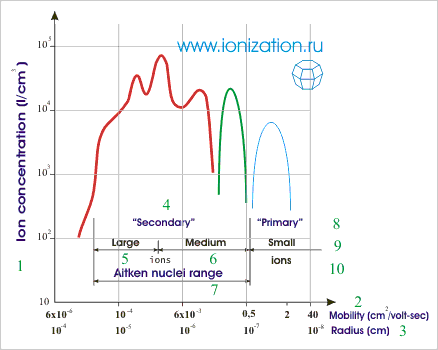From the physics of uncharged gases is known that it is possible to find out not only monomolecular, but also monatomic ions and moreover some heavier ("multi molecular") ions in ionized gases at high pressures. The mobility of these ions is much smaller than the mobility of monomolecular ions; moreover they were found in different gases and mixtures of gases, it was defined while measurement of mobility and with the help of mass spectrography

Picture 1. Spectrum of primary and secondary multi molecular air ions mobility in the range of 10-5 - 2 cm2/ volt-sec. "Primary" multi molecular ions: groups attached to the nucleus that is weighed in the air
Other observations of multi molecular ("atmospheric") ions occurred in meteorology and climatology. They were classified into "small", "medium" and "large" multi molecular ions, where "small" multi molecular ions were determined as ions with mobility smaller than about 2 cm2/volt-sec, "medium" as ions with about 0,01 cm2/volt-sec mobility and "large" ones as ions with mobility smaller than 0,001 cm2volt-sec.
According to Young and Israel, probably, there really exists the spectrum of "air ions" mobility in compliance with "triple" point in the range of mobility from 0,001 up to 2 cm/volt-sec. (Picture 1)
Mote of Aitken nuclei charges "medium" and "large" multi molecular ions, which also exist as neutral particles. Seemingly small ions mainly contain molecules of H2O and O2, but at air pressure CO2 is also possible. Experiments indicate the ionic structure where one of some neutral water molecules or gases attached to one positively or negatively charged monomolecular ion as dipole or by Van der Waals forces. In the earlier theory it was considered that there were stable groups with statistically changing size, which changed if new molecules were added. The last theoretical suppositions postulate complexes of labile ions, which change the quantity of their molecules due to unsteady association and dissociation while migration of parent ion.
Usually it is considered that "small" multi molecular ions, which concentration can change from 50 to 4000 per cm3 in the open air, bioclimatically are more effective than "medium" and "large" ions. Maybe it is caused because of the fact that "small" ions can reach lung alveolus easier than medium and large ions. In climatology there are usually differentiated multi molecular "natural" and "artificial" ions. Cosmic rays, radioactive soil radiation and nucleuses in the air produce natural ions, radioactive sources or electric discharges produce artificial ions.
One more thing should be taken into consideration that these ions have differences in physicochemical structures and that's why there can be differences in biological influence of natural and artificial air ions.
The article was written by Aydar Tuktagulov from materials of Tubingen University (Sapphire Company www.ionization.ru)
THE FULL OR PARTIAL CITATION OF THIS ARTICLE IS FORBIDDEN (write to info@ionization.ru)




